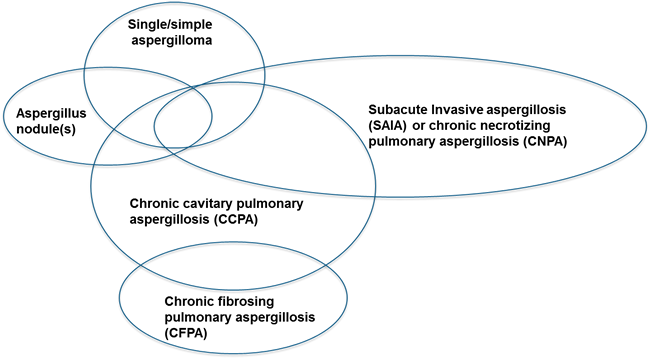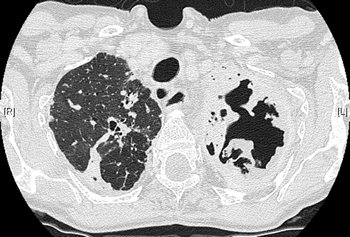Submitted by Jenny on 28 September 2015
At the European Respiratory Society (ERS) Conference in Amsterdam the first world guidelines for chronic pulmonary aspergillosis (CPA) have been presented by Professor Denning of the National Aspergillosis Centre, Manchester, UK. The guidelines have been drawn up in conjunction the ERS and ESCMID and will be published in the European Respiratory Journal in October.
The guidelines describe the 5 clinical phenotypes of CPA and how to diagnose and manage these patients.

Clinical phenotypes of chronic Aspergillus diseases
The three minimum requirements for diagnosis and initial therapy include imaging (radiological & CT scan) (grade A II) – alongside testing for Aspergillus IgG serology (grade A II); and itraconazole treatment (grade A II) or other azole therapy depending on the patient.
Clues to the diagnosis of CPA on imaging include: pleural thickening, any cavitation, irregular edge on the interior wall of a cavity and hyperdense fat associated with pleural thickening. Fungal balls (aspergillomas) are a late manifestation of CPA, with a worse prognosis. A positive Aspergillus IgG is almost always found in CPA.
There are estimated to be 1.2 million CPA patients after TB and a total of 3 million worldwide. link 
The guidelines support the strong message that CPA needs action and antifungals are the cornerstone of treatment for this condition which therefore should include therapeutic drug monitoring. The objective of antifungal therapy in CPA patients would be 4 fold: to control infection, arrest pulmonary fibrosis, prevent haemoptysis and improve the quality of life.
The publication of these guidelines in a few weeks time, will assist and guide the training of medical professionals working with CPA patients and improve patient outcome.
Prof Denning Presentation
26th ECCMID Conference in Istanbul April 2016
News archives
-
Title
Date


